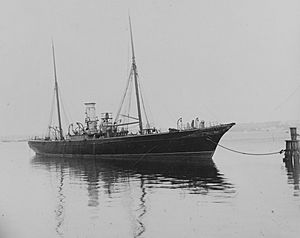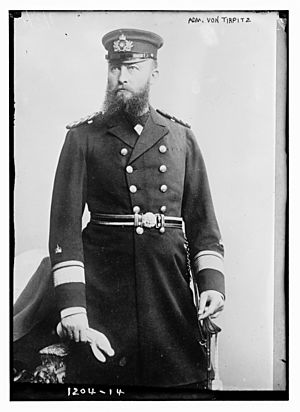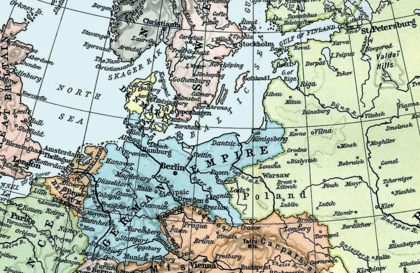SMS Zieten facts for kids

Zieten in port
|
|
Quick facts for kids Class overview |
|
|---|---|
| Preceded by: | Pommerania |
| Succeeded by: | Blitz class |
| History | |
| Name | Zieten |
| Namesake | Hans Joachim von Zieten |
| Builder | Thames Iron Works, Blackwall, London |
| Laid down | 1875 |
| Launched | 9 March 1876 |
| Completed | 15 July 1876 |
| Commissioned | 1 August 1876 |
| Decommissioned | 5 July 1919 |
| Stricken | 6 December 1919 |
| Fate | Sold for scrap, 18 April 1921 |
| General characteristics (as built) | |
| Type | Aviso |
| Displacement |
|
| Length | 79.4 m (260 ft 6 in) overall |
| Beam | 8.56 m (28 ft 1 in) |
| Draft | 3.8 m (12 ft 6 in) |
| Installed power |
|
| Propulsion | |
| Speed | 16 knots (30 km/h; 18 mph) |
| Range | 1,770 nmi (3,280 km; 2,040 mi) at 9 knots (17 km/h; 10 mph) |
| Complement |
|
| Armament | 2 × 38 cm (15 in) torpedo tubes |
SMS Zieten was a special ship built for the Imperial German Navy (Kaiserliche Marine). She was the very first German warship designed to carry torpedoes. Built in Britain between 1875 and 1876, she was the last big warship Germany bought from a foreign country. Zieten was super fast for her time, reaching speeds of 16 knots (30 km/h; 18 mph). This made her the quickest ship in the German fleet.
Zieten was important because she helped develop new warship designs. She influenced how later German ships, like light cruisers, were built. Other navies also copied her design. For many years, Zieten worked with torpedo boats. A famous German admiral, Alfred von Tirpitz, even commanded her. Later, she protected fishing boats and patrolled the coast during World War I. After serving for 45 years, she was sold for scrap in 1921.
Contents
Ship Design and Features
The German Navy wanted to test new Whitehead torpedoes. So, in 1873, they ordered a special ship from a British company called Thames Iron Works. This ship was named Zieten after a famous cavalry leader. She was meant to be a test ship for torpedoes and also to help smaller torpedo boats.
Zieten was the last major warship Germany bought from outside the country. Her design was so good that it became the base for many future German warships. It also inspired other countries like France and Italy to build similar ships.
How Big Was Zieten?
Zieten was about 79.4 m (260 ft 6 in) long from end to end. She was 8.56 m (28 ft 1 in) wide. When she was first built, she weighed about 1,001 metric tons (985 long tons; 1,103 short tons).
The ship's body was made of iron. It had eight sections that could be sealed off to prevent sinking if damaged. At first, she had a small bridge at the front. Later, in 1899, a new superstructure was added. This included a conning tower where the captain could steer and a chart room.
Zieten was good in the water and moved smoothly. She was easy to steer. However, in bad weather, especially against waves, she could be dangerous. She had a crew of 6 officers and 88 sailors. Later, her crew grew to 7 officers and 99 sailors. When she protected fishing boats, she had even more sailors, up to 104.
Engines and Speed
Zieten had two steam engines built by John Penn and Sons. These engines turned two large propellers. Six coal-fired boilers made the steam for the engines. The smoke from the boilers went out through a single tall funnel in the middle of the ship. In 1891, her old boilers were replaced with new ones.
When she was first built, Zieten also had sails, like a schooner. This helped her save coal. But later, most of the sails were removed.
Her engines were designed to produce 2,000 metric horsepower (1,970 ihp) of power. This allowed her to reach a top speed of 16 knots (30 km/h; 18 mph). This speed made her the fastest ship in the German fleet at the time! With her new boilers, she could even go a bit faster, up to 16.3 knots (30.2 km/h; 18.8 mph). Zieten could carry 130 t (130 long tons; 140 short tons) of coal. This gave her a range of 1,770 nautical miles (3,280 km; 2,040 mi) when cruising at 9 knots (17 km/h; 10 mph).
Weapons and Armament
Zieten's main weapons were two 38-centimeter (15 in) torpedo tubes. These tubes were built into the ship's hull, one at the front and one at the back. She carried ten Whitehead torpedoes. These torpedoes, combined with her speed, made her a very powerful ship for her time.
In 1878, the front torpedo tube was moved to the deck. This allowed it to swivel and aim better. Two 12 cm (4.7 in) guns were also added to help defend against smaller ships. She also had six machine guns. Later in her life, the torpedo tubes were removed because they were old-fashioned. She was then rearmed with six 5 cm (1.97 in) SK L/40 guns. These guns could hit targets up to 6,200 m (6,800 yd) away. Zieten could also lay naval mines, carrying up to 49 of them.
Zieten's Service History

Early Years and Torpedo Tests
Zieten was launched on March 9, 1876, and joined the German fleet on August 1, 1876. Her first commander was Franz Mensing. She sailed to the German naval base at Wilhelmshaven. After some final work, she went to a torpedo training school.
In 1877, Alfred von Tirpitz took command of Zieten. He was in charge of testing the new torpedoes. On September 18, Zieten took part in the first big test of Whitehead torpedoes for the German Navy. She hit a target three times, once from 730 m (800 yd) away. This was a huge success!
Because of these tests, the navy decided to change her weapons. In 1878, the front torpedo tube was moved to the deck, and two 12 cm guns were added. Tirpitz, who later became a very important admiral, believed in building many torpedo ships instead of huge battleships.
Zieten continued to test torpedoes and train sailors. In 1879, she sank an old ship called Preussischer Adler with torpedoes. In 1880, she sank another old ship, Barbarossa, during exercises. After this, a newer ship, Blücher, took over her role as the main torpedo training ship.
Fleet Service and Mediterranean Cruise
After a big repair in 1881, Zieten was reclassified as an aviso. She joined a naval review for Kaiser Wilhelm I. In 1882, she sailed to the Mediterranean Sea with other German warships. They were there when the British attacked Alexandria in Egypt. Zieten sent sailors ashore to protect the German embassy and a hospital. She stayed in the area until the situation calmed down, then returned to Germany.
For the next few years, Zieten was mostly kept in reserve. She took part in fleet exercises in 1886. In 1887, her boilers were replaced. In 1888, she joined the Ironclad Training Squadron. She also took Kaiser Wilhelm II on a tour of Baltic ports. She continued to participate in training exercises and royal cruises in 1889 and 1890.
In 1891, Zieten helped two ironclads that had run aground. She continued her training duties until 1892, when she was taken out of service for five years for more big changes.
Protecting Fishermen
In 1897, Zieten got a new job: protecting fishing boats. She replaced another ship, Meteor. For the next 17 years, she sailed all over the North Sea and even near Iceland. Her job was to protect German fishermen from problems with other countries. She also helped ships that were in trouble. During winter, when there was less fishing, she would stay in port with a smaller crew.
In 1897, she helped train sailors about maritime law and medical procedures. She also met with fishery protection ships from other countries to discuss a common signaling system. In 1899, she even arrested a British fishing boat for fishing illegally.
In 1900, Zieten underwent another major rebuild that changed her look. In 1901, she explored fishing grounds near Iceland. She also celebrated her 25th anniversary. She continued her fishery protection duties, sometimes with the help of torpedo boats. She also took part in fleet exercises. In 1908, she helped rescue people from hot air balloons that had been blown out to sea. In 1909, she searched for missing fishing boats in a bad storm.
In 1910, she had another big repair. In 1911, she started testing wireless telegraph communication with fishing boats. She continued to stop British ships that were fishing illegally in German waters in 1912 and 1914.
World War I and Final Days
When World War I started in July 1914, Zieten was called into action. She became part of Germany's coastal defense forces. She patrolled the Jade Bay and the mouth of the Weser River for most of the war. In July 1918, she became the leader of a group of patrol vessels in the Elbe River.
After the war ended in November 1918, Zieten's crew was reduced. She still served in 1919, making trips in the North Sea. She helped guide a lightvessel and even escorted German U-boats to be surrendered to the British.
Zieten was taken out of service on July 5, 1919, after almost 43 years. She was one of the longest-serving ships in the Imperial German fleet. She was officially removed from the navy's list on December 6, 1919. Finally, on April 18, 1921, she was sold for scrap and broken up in Wilhelmshaven.
Images for kids
-
Alfred von Tirpitz, who commanded Zieten from 1878 to 1880





